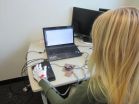(Press-News.org) Several years ago, Georgia Institute of Technology researchers created a technology-enhanced glove that can teach beginners how to play piano melodies in 45 minutes. Now they've advanced the same wearable computing technology to help people learn how to read and write Braille. The twist is that people wearing the glove don't have to pay attention. They learn while doing something else.
"The process is based on passive haptic learning (PHL)," said Thad Starner, a Georgia Tech professor and wearable computer pioneer. "We've learned that people can acquire motor skills through vibrations without devoting active attention to their hands."
In their new study, Starner and Ph.D. student Caitlyn Seim examined how well these gloves work to teach Braille. Each study participant wore a pair of gloves with tiny vibrating motors stitched into the knuckles. The motors vibrated in a sequence that corresponded with the typing pattern of a pre-determined phrase in Braille. Audio cues let the users know the Braille letters produced by typing that sequence. Afterwards, everyone tried to type the phrase one time, without the cues or vibrations, on a keyboard.
The sequences were then repeated during a distraction task. Participants played a game for 30 minutes and were told to ignore the gloves. Half of the participants felt repeated vibrations and heard the cues; the others only heard the audio cues. When the game was over, participants tried to type the phrase without wearing the gloves.
"Those in the control group did about the same on their second attempt (as they did in their pre-study baseline test)," said Starner. "But participants who felt the vibrations during the game were a third more accurate. Some were even perfect."
The researchers expected to see a wide disparity between the two groups based on their successful results while using the piano glove. But they were surprised the passive learners picked up an additional skill.
"Remarkably, we found that people could transfer knowledge learned from typing Braille to reading Braille," said Seim. "After the typing test, passive learners were able to read and recognize more than 70 percent of the phrase's letters."
No one in the study had previously typed on a Braille keyboard or knew the language. The study also didn't include screens or visual feedback, so participants never saw what they typed. They had no indication of their accuracy throughout the study.
"The only learning they received was guided by the haptic interface," said Seim.
Seim is currently in the middle of a second study that uses PHL to teach the full Braille alphabet during four sessions. Of the eight participants so far, 75 percent of those receiving PHL reached perfect typing performance. None of the control group had zero typing errors. PHL participants have also been able to recognize and read more than 90 percent of all the letters in the alphabet after only four hours.
Nearly 40 million people worldwide are blind. However, because Braille instruction is widely neglected in schools, only 10 percent of those who are blind learn the language. Braille is also difficult to learn later in life, when diabetics, wounded veterans or older people are prone to lose their sight.
The Braille studies will be presented in Seattle this September at the 18th International Symposium on Wearable Computers (ISWC).
In addition to teaching the piano, the researchers have previously demonstrated that the glove can improve sensation and mobility for people with spinal cord injury.
INFORMATION:
This research was partially supported by the National Science Foundation (NSF) under grant 1217473. Any conclusions expressed are those of the principal investigator and may not necessarily represent the official views of the NSF.
Wearable computing gloves can teach Braille, even if you're not paying attention
2014-06-23
ELSE PRESS RELEASES FROM THIS DATE:
Can magnetic fields accurately measure positions of ferromagnetic objects?
2014-06-23
Many creatures in nature, including butterflies, newts and mole rats, use the Earth's inherent magnetic field lines and field intensity variations to determine their geographical position. A research team at the University of Minnesota has shown that the inherent magnetic fields of ferromagnetic objects can be similarly exploited for accurate position measurements of these objects. Such position measurement is enabled in this research by showing that the spatial variation of magnetic field around an object can be modeled using just the geometry of the object under consideration. ...
Breakthrough drug-eluting patch stops scar growth and reduces scar tissues
2014-06-23
Scars — in particular keloid scars that result from overgrowth of skin tissue after injuries or surgeries — are unsightly and can even lead to disfigurement and psychological problems of affected patients. Individuals with darker pigmentation — in particular people with African, Hispanic or South-Asian genetic background — are more likely to develop this skin tissue disorder. Current therapy options, including surgery and injections of corticosteroids into scar tissues, are often ineffective, require clinical supervision and can be costly.
A new invention by researchers ...
D-Wave and predecessors: From simulated to quantum annealing
2014-06-23
The D-Wave computer is currently the latest link of a long chain of computers designed for the solution of optimization problems. In what sense does it realize quantum computation? We describe the evolution of such computers and confront the different views concerning the quantum properties of the D-wave computer.
Quantum algorithms show several benefits over classical ones. One strong example suggested by Shor in 1994 is the ability to factor numbers which can be effectively done on a quantum computer but is very hard on a classical computer. However, the actual model ...
New data bolsters Higgs boson discovery
2014-06-23
If evidence of the Higgs boson revealed two years ago was the smoking gun, particle physicists at Rice University and their colleagues have now found a few of the bullets.
The European Organization for Nuclear Research (CERN) published research in Nature Physics this week that details evidence of the direct decay of the Higgs boson to fermions, among the particles anticipated by the Standard Model of physics.
The finding fits what researchers expected to see amid the massive amount of data provided by the Large Hadron Collider (LHC). The world's largest collider smashed ...
MIT researchers unveil experimental 36-core chip
2014-06-23
CAMBRIDGE, MA -- The more cores — or processing units — a computer chip has, the bigger the problem of communication between cores becomes. For years, Li-Shiuan Peh, the Singapore Research Professor of Electrical Engineering and Computer Science at MIT, has argued that the massively multicore chips of the future will need to resemble little Internets, where each core has an associated router, and data travels between cores in packets of fixed size.
This week, at the International Symposium on Computer Architecture, Peh's group unveiled a 36-core chip that features just ...
Anti-androgen therapy for triple-negative breast cancer may benefit lower-androgen tumors
2014-06-23
Triple-negative breast cancers do not benefit from the targeted therapies that have greatly improved the survival of patients with other subtypes of breast cancer. But recent work shows that while these cancers lack estrogen receptors, progesterone receptors, and aren't driven by the gene HER2, up to a third of these tumors express the androgen receptor – clinical trials are underway to inhibit the androgen receptor in these tumors in much the same way that the drug Tamoxifen inhibits estrogen receptor in estrogen-receptor-positive breast cancers. A new University of Colorado ...
Study finds minimum payment warnings nudge credit card payments up AND down
2014-06-23
Chestnut Hill, MA (June 23, 2014): If you were warned how much extra credit card interest you'd pay by only making the minimum payment every month, you might want to increase your payments to retire the balance earlier, right? Not necessarily, according to a study by a Boston College marketing researcher who found that telling customers about the high cost of repaying the monthly minimum had little impact on repayment decisions. But when credit card consumers were shown a three-year payoff time frame with accompanying lower interest costs, this information "nudge" had ...
Gestures that speak
2014-06-23
Have you ever found yourself gesticulating – and felt a bit stupid for it – while talking on the phone? You're not alone: it happens very often that people accompany their speech with hand gestures, sometimes even when no one can see them. Why can't we keep still while speaking? "Because gestures and words very probably form a single "communication system", which ultimately serves to enhance expression intended as the ability to make oneself understood", explains Marina Nespor, a neuroscientist at the International School for Advanced Studies (SISSA) of Trieste. Nespor, ...
Poor awareness of the proper injection techniques adversely affects glucose control
2014-06-23
CHICAGO, IL — Diabetic patients who don't know proper injection techniques may administer insulin incorrectly, leading to poor glycemic control and adverse outcomes, a new study from Iraq finds. The results were presented in a poster Monday, June 23 at ICE/ENDO 2014, the joint meeting of the International Society of Endocrinology and the Endocrine Society in Chicago.
"Lack of simple education about proper injection techniques could be blamed for many complications and adverse outcomes. I thought about conducting this study after managing two teenage patients who suffered ...
A new spider species from Mexico uses soil particles for camouflage
2014-06-23
Scientists discover and describe a new species of spider from Mexico. The new species belongs to the enigmatic family Paratropididae that is distinguished by representatives who possess unique camouflaging abilities. The study was published in the open access journal ZooKeys.
Like all species form the family the new species Paratropis tuxtlensis has its entire body encrusted with soil particles. The encrusted soil on the exoskeleton could provide protection from predators or serve as camouflage to deceive their prey. The encrusted soil particles are because this species ...



